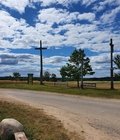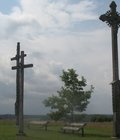At the end of 1944, the guns of the Second World War were still thundering, but there were no active direct military actions on the territory of Lithuania. The Soviet Union tried to impose and consolidate its power here in various ways. In the winter of 1944-1945, due to the constant rampages of the NKVD troops, Lithuania suffered perhaps the most losses during the entire period of occupation. Many of the victims at that time were not members of the resistance or associated with the armed underground. Chekists burned villages, and killed their inhabitants, classifying them as "forest bandits" or their supporters. They aimed to intimidate, stop and destroy the armed partisan groups that spontaneously began to operate and form throughout Lithuania. These atrocities were used to intimidate the local population so that they would not participate in the resistance or support it. In that period, not one campaign of this kind is known in Lithuania. One of the most famous and cruelest took place on December 23, 1944, in the village of Klepočiai in the Alytus district. Her timing was also well chosen. St. Christmas is a holiday of peace and the whole family when the separated family tries to gather around the Christmas table. Instead, it was expected that partisans or those hiding alone would return home from the forest for the holidays. The idea was to destroy as many young men as possible. Homesteads were surrounded, the residents were brutally beaten, tortured, killed, and after the buildings were set on fire, they were thrown into the fire while they were still alive.
According to the memoirs of witnesses, published in 1989, in the village of Klepočiai alone, during a punitive action on December 23, 1944, 21 homesteads (out of 32 that were there) were burned, and 12 residents of this village were shot or burned alive.
Killed villagers:
Adams Baranauskas (60-70 years old),
Vaitiekus Kasiulynas (55-60 years old),
Jonas Mikalonis (60-75 years old),
Juozas Mikalonis (45 years old),
Kazys Mikalonis (disabled 20-25 years old),
Rokas Mikalonis (50 years old),
Andrius Muzikevičius (60-65 years old),
Bronius Muzikevičius (25-30 years old),
Juozas Muzikevičius (45-50 years old),
Kazys Muzikevičius (35-40 years old),
Vytautas Muzikevičius (18-year-old high school student),
Vladas Muzikevičius (50-60 years old).
The young men from the vicinity of Ryliškii and Klepočiai, whom they wanted to recruit for the army, were in hiding: there were no men of that age either among those killed or among those arrested. Several dozen men from those villages were arrested. A few were released, and others were taken to Merkina with their hands tied with wire, and from there many were expelled to Alytus.
Punishers remained in the vicinity of Ryliškii and Klepotiči on December 24, only they did not burn down any more farmhouses (they had already been destroyed), but they still arrested men and interrogated them (the most important element of the interrogations was the indiscriminate beating of the arrested). The horses, cows, and other animals saved from the fires were later collected by the soldiers and driven to Merkina. Moving on, the punitive expedition reached Makniūnis, Noškūnis, Galintankas, Galintėnis, Kastriškes, Vangelonis, and Nemunaitis.
in 1944 December 23 Punishers burned down 45 homesteads and killed 23 men in the northern part of Merkina township in Panemuni.
In this region alone, at the end of December 1944, on Christmas Day, NKVD units and self-defense units surrounded the villages located between Ryliškii and Nemunaitis. They burned and killed the inhabitants of Klepočiai, Lizda, Ryliškii, Druskininkai, Taručioni, Mižonii, Pieriškii, Vabalii, Ferma, Dubrii, Vertelkii, and other villages. 37 people were brutally killed, and about 70 homesteads were burned.
Wooden crosses were erected to commemorate these events in 1990, where the homestead of the murdered Vaitiekus Kasiulynas stood.
GPS: 54.203670, 24.000524 (WSG)
Authors of photos: V. Skendelis, V. Strumskienė.





Reviews